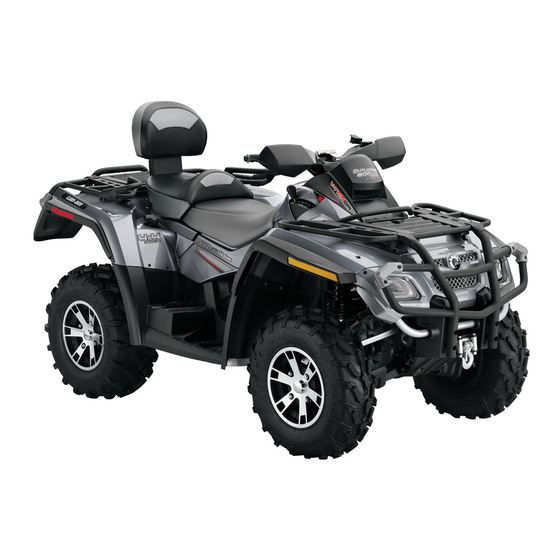Summarization of Contents
SAFETY INFORMATION
SPECIAL SAFETY MESSAGES
Crucial safety precautions and warnings for vehicle operation.
OPERATION WARNINGS
Potential hazards and avoidance measures as per safety commission requirements.
RIDING THE VEHICLE
Essential tips and rules for safe and enjoyable vehicle riding.
HANG TAG
Importance of reading hang tags and on-product labels before riding.
ON-PRODUCT LABELS
Identification and significance of on-vehicle safety and operational labels.
VEHICLE INFORMATION
HOW TO IDENTIFY YOUR VEHICLE
Locating engine and vehicle identification numbers for warranty and tracing.
EMISSION REQUIREMENTS
Details California Air Resources Board (CARB) emission compliance requirements.
BREAK-IN PERIOD
Outlines necessary break-in procedures for engine and belt for optimal performance.
CONTROLS/INSTRUMENTS/EQUIPMENT
Identifies and describes the function of various vehicle controls and instruments.
LIQUIDS
Fuel
Recommended fuel type, octane rating, and refueling safety precautions.
Engine Oil
Recommended engine oil specifications and viscosity for optimal performance.
Gearbox Oil
Recommended gearbox oil type and procedures for checking its level.
Engine Coolant
Recommended coolant type and procedures for checking coolant level.
Brake Fluid
Recommended brake fluid type and procedures for checking fluid levels.
OPERATING INSTRUCTIONS
Pre-Operation Check
Critical pre-ride checks to ensure vehicle safety and proper operation.
Starting the Engine
Step-by-step instructions for safely starting the vehicle's engine.
Shifting the Transmission
Explanation of how to properly shift gears for various riding conditions.
Stopping the Engine
Correct procedure for safely shutting down the vehicle's engine.
SPECIAL PROCEDURES
Turn Over
Instructions for handling the vehicle if it overturns or remains tilted.
Vehicle Immersion
Immediate actions required if the vehicle is submerged in water.
CARGO AND TRANSPORTATION
Cargo
Maximum load capacities and guidelines for safe cargo distribution and transport.
Transportation
Instructions for securing and transporting the vehicle on trailers or in pickup boxes.
TROUBLESHOOTING
ENGINE DOES NOT TURN
Potential causes and solutions for engine failure to crank.
ENGINE TURNS OVER BUT FAILS TO START
Troubleshooting steps for when the engine cranks but does not start.
ENGINE LACKS ACCELERATION OR POWER
Addresses issues of poor engine performance, lack of power, or overheating.
SPECIFICATIONS
ENGINE
Technical details on engine type, displacement, bore, stroke, and lubrication.
ELECTRICAL SYSTEM
Specifications for ignition, battery, lamps, fuses, and electrical components.
FUEL SYSTEM
Details on fuel delivery, pump, idle speed, and fuel tank capacity.
DRIVE TRAIN
Specifications for drive shafts, differentials, and CV joints.
SUSPENSION
Details on suspension types, travel, shock absorbers, and adjustment.
BRAKES
Specifications for brake system type, fluid capacity, pads, and discs.
TIRES AND WHEELS
Tire pressure, size, wheel specifications, and torque values.
DIMENSION
Overall vehicle dimensions, weight, wheelbase, and track width.
LOADING CAPACITY
Weight distribution, rack capacities, and towing specifications.
MAINTENANCE INFORMATION
MAINTENANCE CHART
Comprehensive chart for periodic maintenance tasks and intervals.
ENGINE MAINTENANCE
Procedures for engine upkeep, including air filter and oil changes.
ELECTRICAL SYSTEM MAINTENANCE
Maintenance for spark plugs, battery, fuses, and lighting components.
DRIVE TRAIN & SUSPENSION MAINTENANCE
Maintenance for drive shafts, wheels, tires, and suspension systems.
BRAKE & BODY/FRAME MAINTENANCE
Inspection and maintenance for brakes, body, and frame components.
STORAGE AND PRESEASON PREPARATION
Guidance on proper storage procedures and preparation after storage.
BRP LIMITED WARRANTY NORTH AMERICA
1) SCOPE OF THE LIMITED WARRANTY
Defines the period and conditions covered by the limited warranty.
2) EXCLUSIONS – ARE NOT WARRANTED
Lists items and circumstances explicitly not covered by the warranty.
4) WARRANTY COVERAGE PERIOD
Specifies the duration of warranty coverage for different components and usage.
5) CONDITIONS TO HAVE WARRANTY COVERAGE
Outlines the requirements that must be met to maintain warranty coverage.
9) CONSUMER ASSISTANCE
Guides on how to seek assistance and resolve warranty-related disputes.
BRP INTERNATIONAL LIMITED WARRANTY
1) SCOPE OF THE LIMITED WARRANTY
Defines the warranty period and conditions for international Can-Am ATVs.
5) CONDITIONS TO HAVE WARRANTY COVERAGE
Details the prerequisites for obtaining warranty coverage for international buyers.
BRP EUROPEAN UNION MEMBER STATES LIMITED WARRANTY
1) SCOPE OF THE LIMITED WARRANTY
Outlines the warranty scope and conditions for ATVs in EU member states.
5) CONDITIONS TO HAVE WARRANTY COVERAGE
Details the requirements for warranty coverage for EU market ATVs.















Need help?
Do you have a question about the Outlander 650 2008 and is the answer not in the manual?
Questions and answers